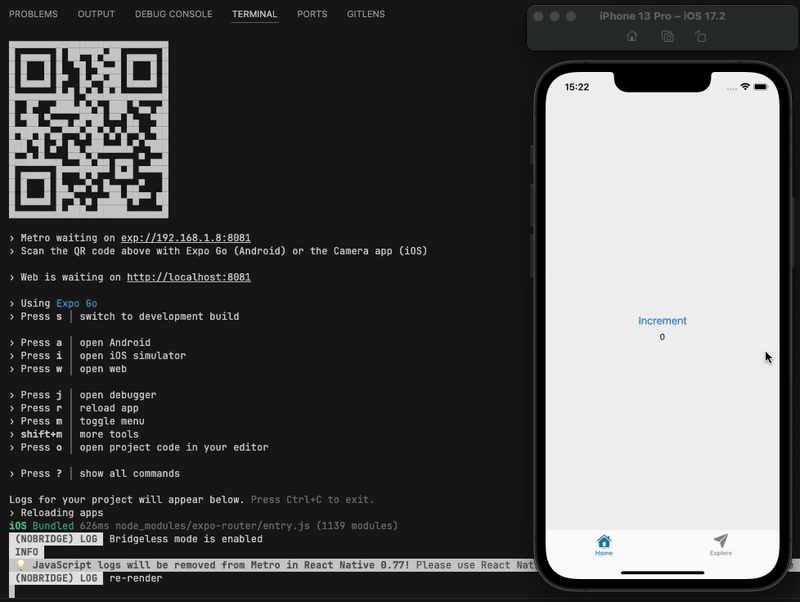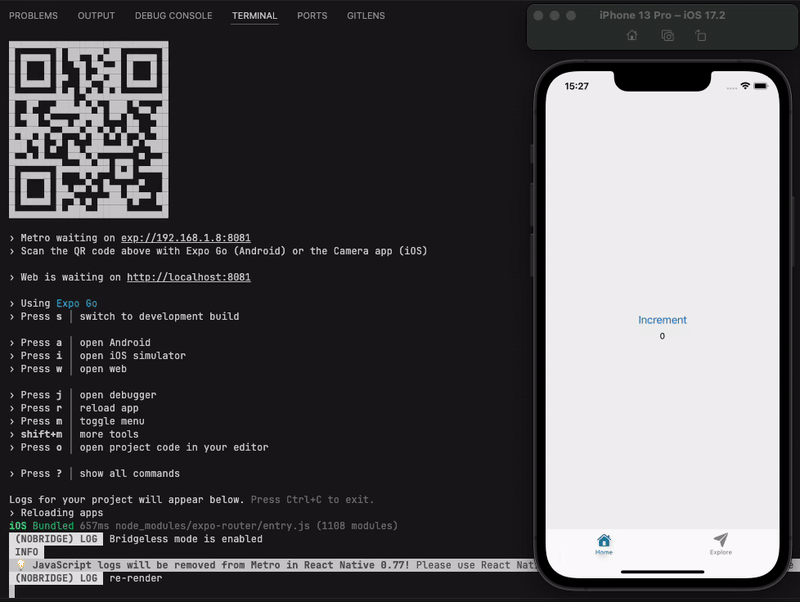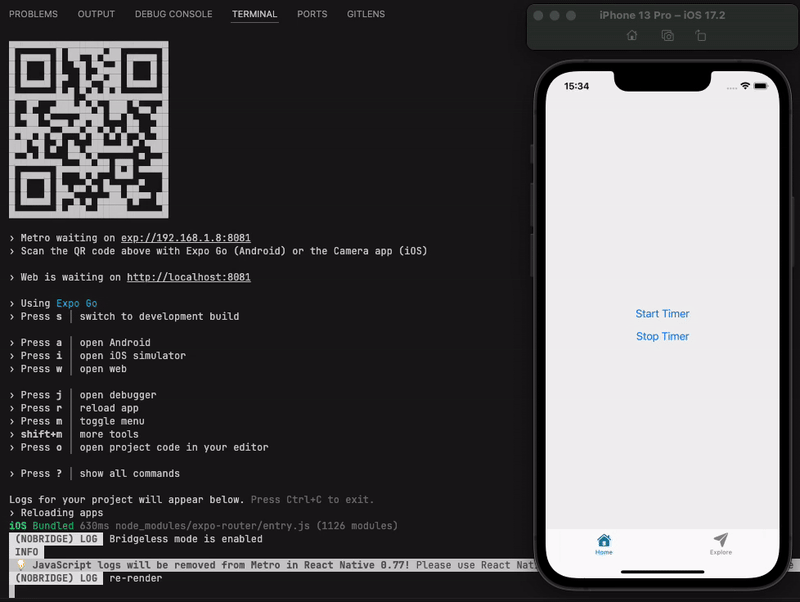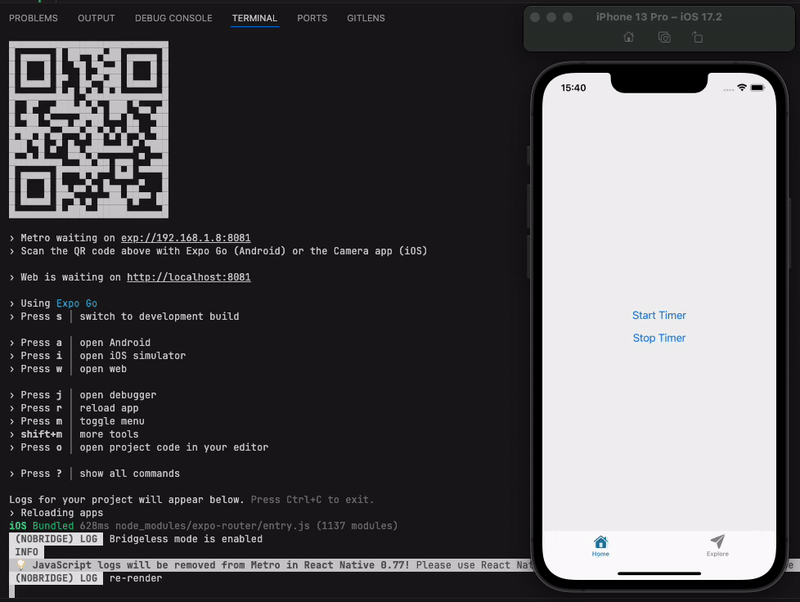
useRef x useState in React Native
React Native allows developers to build mobile applications using React, which makes it a powerful tool for creating cross-platform apps. Just like in React for the web, React Native offers hooks such as useRef and useState to manage state and references. However, understanding when and why to use one over the other can sometimes be tricky, especially when you’re working with mobile-specific behaviors and performance considerations.
In this article, we’ll explore the key differences between useRef and useState in React Native, and discuss their advantages and disadvantages to help you make the best choice for your projects.
To follow along, we’ll use Expo to create our React Native application. You can create the app by running npx create-expo-app@latest on your terminal and naming the project userefxusestate.
Next, we’ll remove all content from the home screen and dive into our study, starting with useState.
What is useState?
useState is a hook that lets you add state to your functional components. When the state changes, the component re-renders to reflect the updated state. This makes useState essential for handling user interactions, fetching data, or any situation where you need to trigger a re-render based on state changes.
Let’s create a button that increments a counter, starting at 0:
import { useState } from "react";
import { StyleSheet, View, Button, Text } from "react-native";
export default function HomeScreen() {
const [count, setCount] = useState(0);
const handleOnPress = () => {
setCount(count + 1);
};
console.log("re-render");
return (
<View style={styles.container}>
<Button title="Increment" onPress={handleOnPress} />
<Text>{count}</Text>
</View>
);
}
const styles = StyleSheet.create({
container: {
alignItems: "center",
justifyContent: "center",
height: "100%",
},
});
In the example above, count is a piece of state that triggers a re-render of the component every time its value changes. Each time you call setCount, the component re-renders with the updated value.
Notice that every time I click the increment button, a new re-render log occurs.

But this won’t happen when we use useRef!
What is useRef?
useRef is a hook that creates a mutable object that persists for the lifetime of the component. The value stored in a ref doesn’t trigger a re-render when changed. This makes it ideal for storing values that shouldn’t cause a re-render, such as DOM references, timers, or any mutable data that doesn’t affect the UI.
Let’s look at the same example using useRef and see the behavior:
import { useRef } from "react";
import { StyleSheet, View, Button, Text } from "react-native";
export default function HomeScreen() {
const count = useRef(0);
const handleOnPress = () => {
count.current += 1;
console.log("Current Count:", count.current);
};
console.log("re-render");
return (
<View style={styles.container}>
<Button title="Increment" onPress={handleOnPress} />
<Text>{count.current}</Text>
</View>
);
}
const styles = StyleSheet.create({
container: {
alignItems: "center",
justifyContent: "center",
height: "100%",
},
});
In this version, I added a log in the handleOnPress function to display the current count.
Notice how the screen doesn’t change! Even though the ref is being updated, it doesn’t cause a re-render, because useRef doesn’t trigger one when the value of count.current changes.

Now, let’s look at an example where using useRef makes more sense.
Using useRef for Timer Logic
Consider the following example, where we use useRef to manage a timer:
import { useRef } from "react";
import { StyleSheet, Button, View } from "react-native";
export default function HomeScreen() {
const timerRef = useRef<NodeJS.Timeout | null>(null);
console.log("re-render");
const startTimer = () => {
timerRef.current = setInterval(() => {
console.log("Timer is running...");
}, 1000);
};
const stopTimer = () => {
if (timerRef.current) {
clearInterval(timerRef.current);
console.log("Timer stopped.");
}
};
return (
<View style={styles.container}>
<Button title="Start Timer" onPress={startTimer} />
<Button title="Stop Timer" onPress={stopTimer} />
</View>
);
}
const styles = StyleSheet.create({
container: {
alignItems: "center",
justifyContent: "center",
height: "100%",
},
});
In this example, timerRef stores a reference to the timer interval. Changing timerRef.current doesn’t trigger a re-render, which is exactly what we want for non-UI-related logic like timers or external integrations.

Now, let’s look at the behavior using useState.
Using useState for Timer Logic
import { useState } from "react";
import { StyleSheet, Button, View } from "react-native";
export default function HomeScreen() {
const [timer, setTimer] = useState<NodeJS.Timeout | null>(null);
console.log("re-render");
const startTimer = () => {
const id = setInterval(() => {
console.log("Timer is running...");
}, 1000);
setTimer(id);
};
const stopTimer = () => {
if (timer) {
clearInterval(timer);
console.log("Timer stopped.");
setTimer(null);
}
};
return (
<View style={styles.container}>
<Button title="Start Timer" onPress={startTimer} />
<Button title="Stop Timer" onPress={stopTimer} />
</View>
);
}
const styles = StyleSheet.create({
container: {
alignItems: "center",
justifyContent: "center",
height: "100%",
},
});

Here, by using useState, we trigger two unnecessary re-renders: one for setting the interval, and one for clearing it. In total, that’s two more re-renders, compared to when using useRef. If we look from another perspective, that’s three times more re-renders, considering the first re-render always happens when then screen is mounted.
Key Differences Between useState and useRef
| Aspect | useState | useRef |
|---|---|---|
| Purpose | Stores state that triggers re-renders. | Stores mutable values that don’t trigger re-renders. |
| Triggers Re-render | Yes, any change to the state triggers a re-render. | No, changing ref.current doesn’t trigger re-renders. |
| Use Case | For UI-related state that affects rendering. | For values or references (like DOM elements) that don’t affect rendering. |
| Example Use | Form inputs, counters, toggles, etc. | Timer references, external libraries, DOM element references. |
When to use useState
Use useState when you need to track and update values that affect your component’s output. This could be anything from form inputs to counters or data fetched from an API.
When to use useRef
On the other hand, use useRef when you need to store a reference to a DOM element (in React Native, this might be a View, for instance) or a value that persists across renders without causing re-renders. It’s ideal for scenarios like managing timers, storing previous state values, or accessing mutable objects (such as third-party libraries).
Conclusion
Both useRef and useState are powerful hooks for managing state and references in React Native apps. The key takeaway is that useState is best for values that need to trigger re-renders when updated, while useRef is perfect for values that persist without causing unnecessary renders.
By understanding the differences between these two hooks, you can write more efficient and performant React Native code!